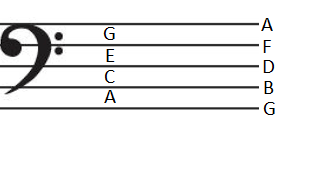
Music Theory For Beginners
Hello everyone and welcome to the third lesson in my series Music Theory for beginners, in this series I am going to be covering some basic music theory that will be able to help any player improve their musicianship in general and help them to improve on their chosen instrument.
In the previous lessons, we have looked at the notes on the treble clef and how to add ledger lines to the stave to give us more range when we are writing down our music.
In this lesson, we are going to add even more range by introducing the Bass Clef. This is going to allow you to write notes which have a lot deeper pitch than the ones that can be represented on the Treble Clef. Don't worry too much about the ideas of pitch and intervals so much at the moment, once we understand the system in which we write music, it will be much easier for we to teach new concepts using this system.
The Bass Clef
Have a look at the image below to see what the bass clef looks like. As with the treble clef being known as the G clef, the bass clef can also be referred to as the F clef(due to the line between the two dots representing the note F).
.png)
The bass clef works in the same way as the treble clef in the regards that it denotes which notes are represented on the stave. If you have a look at the image below I have included a bass clef which shows the notes represented by this clef on the stave.

In this image you can see just like the treble clef there are notes on the lines and in the spaces, with the notes G B D F and A on the lines and A C E and G filling up the spaces in between. You can make up rhymes to remember these as well. The one that is stuck in my mind is Good Boys Deserve Food Always for the lines and for the spaces I just remember the word ACE and work from there.
Challenge
For this challenge, we are going to be looking at adding ledger lines with the bass clef. These ledger lines work exactly the same as with the treble clef, the only difference being that they represent different notes.
Your challenge is to represent all of the notes on the stave up to three ledger lines above and below for the notes A C and G. Look below to see an example for the note A.
.png)
Post your own solutions in the comments section.
Conclusion
In this section, we have covered the basics of the bass clef. It is important that you learn the notes on both the treble and the bass clef before moving forward as they will be the foundations for all future lessons
Message to readers
Thanks for taking the time to read my post, if you are interested in Music, Science, Technology or Computer Science then check out my blog, I am making an effort to provide good quality original content to the Steemit community.
I am liking the step by step on everything.
cheers buddy
You received an upvote from @MusicVoter due to the musical content of this post.
To find out how I decide who to up vote please READ THIS